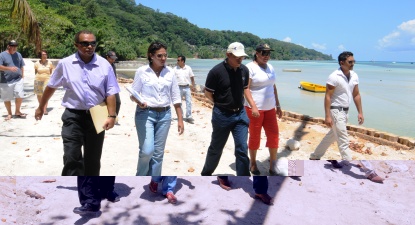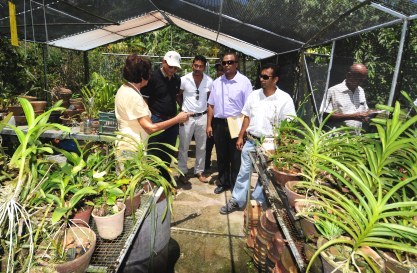Timely action saves Anse à La Mouche |09 April 2012

Environment and Energy Minister Dr Rolph Payet said this on Thursday when he inspected rehabilitation of the beach at Anse à La Mouche and Anse Royale which were seriously threatened.
“Something tangible has been done to save Anse à La Mouche,” he said, adding the work was done just in time – ahead of the storm with high tides which wreaked havoc at Beau Vallon, notably at Mare Anglaise.
He said the weather could have caused a similarly heavy toll at Anse à La Mouche if no preventive work had been done, noting efforts to save the beach started after President James Michel visited it in September.
The work has entailed timber piling or driving casuarina poles into the sand, and burying them 1.5 metres. This has been done in two rows for most of the 178 metres. At the bottom geotextil fabric is laid, which acts as a membrane allowing the water to pass through as the tides come, but holding back the sand.
Rock is also used for support, though not visible. Several hundred tons of coral fill was then dumped into the elongated depression formed, reclaiming a shoreline about 25 metres wide parallel to the main road.
The timber piling is curved rather than straight to match the topography of the beachscape.
During the visit, Dr Payet was accompanied by his principal secretary Wills Agricole, and was shown various schemes to rehabilitate the beaches by the director for environmental engineering and wetlands, Nim Sanetra.
When the President visited the area, the beach – especially at Anse à La Mouche near the Anchor Café and Blue Lagoon Chalets – was being badly hit by erosion, with trees on the shoreline in great danger of being washed away.
Mr Michel – who spent his childhood in that area – was very sad and said whatever measures necessary must be taken to save the coastline.
Once the necessary funds were allocated, the project began in earnest, headed by Mr Sanetra.
Now, 10 weeks later, a shoreline 178 metres long has been rehabilitated and Dr Payet – who was present during the September visit – said he was satisfied with the work done to date.
Keith Berke and Ferial Janker, the owners of Anchor Café-Islander Restaurant and Blue Lagoon Chalets respectively, who were also present during the minister’s tour, agree that the piling most probably saved the remaining Takamaka trees, which were lurching precariously towards the sea.
They noted the main road was in serious peril, as erosion was gaining steadily inland.
Dr Payet said trees and shrubs must be planted on what has become a “promenade” shoreline to protect it and make it more beautiful.
He also took up an invitation by Ms Janker to visit her nursery, which boasts a variety of palms, succulents and other plants, some of which may be replanted on the new promenade.
From Anse à La Mouche, the minister went to Anse Royale where he was welcomed by the district’s member of the National Assembly Dereck Samson.
At Anse Royale, where beach erosion was not as acute and in most places, rock armouring has been used, sometimes with a combination of timber piling.
The area visited is destined to become a leisure park. In a few instances, some people who have been on picnics there have left their litter behind.
Dr Payet said he hopes the community, including the schools will be more involved in environmental conservation.
On Thursday afternoon, Dr Payet visited the Biodiversity Centre at Barbarons, which presently holds half of Seychelles’ 75 endemic plants.
The roles of the 50-acre garden include the propagation of endemic plant species and giving seeds and cuttings as plant material.
Such species include Bwad Nat, which early settlers felled extensively so few trees remain. There is also Bwa Sitron, Bwa Rouz and Bilenbi Maron.
One area of the centre has been developed into a palm garden.
Dr Payet said the centre has the potential to become a valuable tourism attraction, as well as promoting environmental protection among residents.





